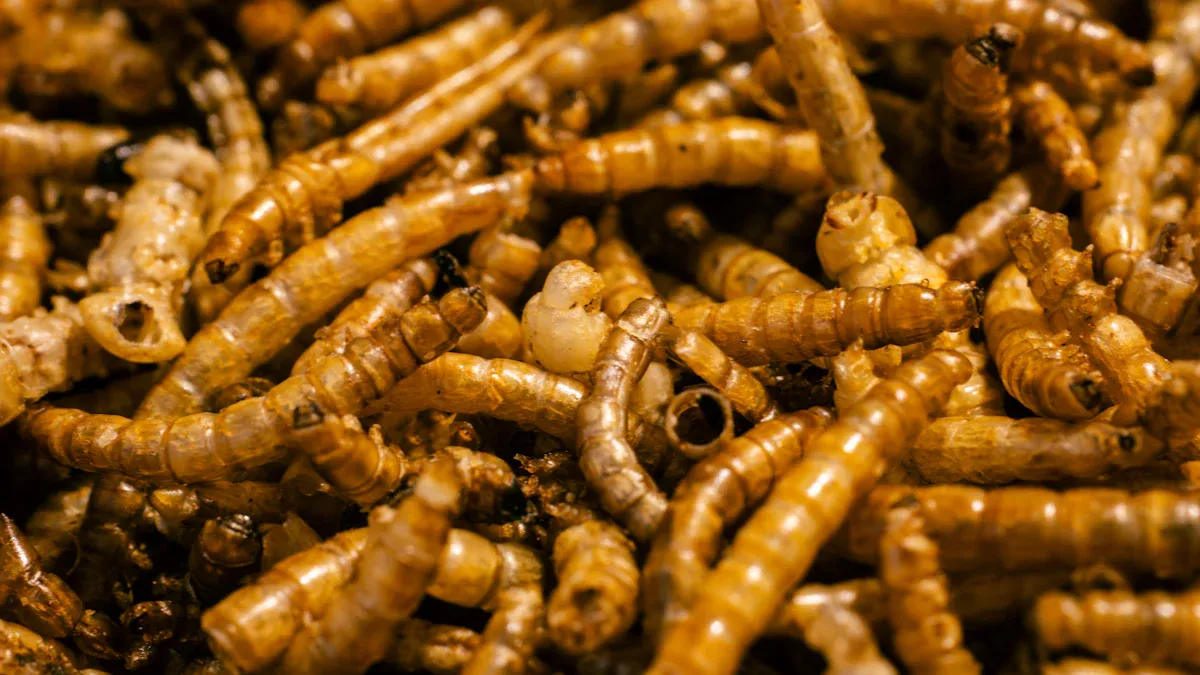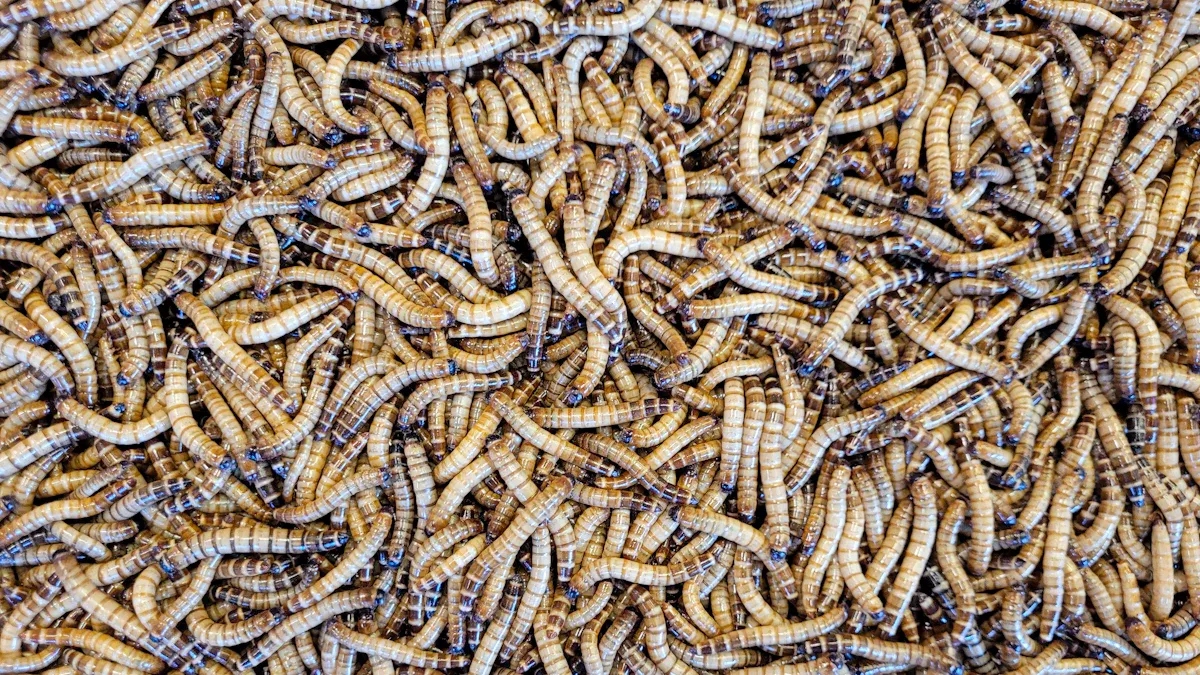
Choosing between live and freeze-dried mealworms depends on your pet’s needs and your convenience. Live mealworms offer 72.4% moisture, while mealworms freeze dried contain 53.8% protein. Dried options cost $2.50 per 100g, making them more economical. Studies show pets enjoy live mealworms but adapt well to dried ones when needed.
Key Takeaways
- Live mealworms give water and encourage pets to hunt naturally. They are great for reptiles and amphibians.
- Freeze-dried mealworms cost less and are simple to keep. They can last up to a year without a fridge, which helps busy owners.
- Trying both live and freeze-dried mealworms can show what your pet likes. This also helps them get a healthy diet.
Nutritional Comparison of Mealworms Freeze Dried vs Live
Protein and Nutritional Content
When comparing live and freeze-dried mealworms, their nutritional profiles differ significantly. Freeze-dried mealworms pack a punch with higher protein and fat content, making them a concentrated source of energy. On the other hand, live mealworms provide fewer calories but still offer a decent amount of protein. Here’s a quick breakdown:
| Nutrient | Live Mealworms | Dried Mealworms |
|---|---|---|
| Calories (kcal) | 109 | 483 |
| Proteína (%) | 19.5 | 53.8 |
| Fat (%) | 13.6 | 28.9 |
| Fiber (%) | 1.1 | 0.8 |
| Moisture (%) | 72.4 | 6.5 |
| Ash (%) | 1.7 | 5.4 |
For pets needing a protein boost, freeze-dried mealworms are a great choice. However, live mealworms can still meet the needs of animals requiring less concentrated nutrition.
Moisture Levels and Hydration Benefits
Live mealworms contain over 70% moisture, making them an excellent option for pets that need hydration. This is especially important for reptiles and amphibians, which often rely on their food for water intake. Freeze-dried mealworms, with only 6.5% moisture, lack this benefit. Pet owners feeding dried mealworms should ensure their pets have access to fresh water to prevent dehydration. While freeze-dried mealworms are convenient, they may not be ideal for animals that thrive on moisture-rich diets.
Health Risks and Safety Concerns
Both live and freeze-dried mealworms come with potential risks. Live mealworms can carry pathogens or parasites if raised in unsanitary conditions. Freeze-dried mealworms, while safer in this regard, may lose some nutrients during processing. Additionally, mealworm proteins can trigger allergies in some pets or even humans. Studies show that individuals allergic to shrimp or dust mites might experience severe reactions when exposed to mealworms. Here’s a summary of potential hazards:
| Hazard Type | Details |
|---|---|
| Toxin Accumulation | Poor-quality feed can lead to toxin buildup in mealworms. |
| Allergy Risk | Proteins in mealworms may cross-react with allergens from crustaceans or dust mites. |
| Severe Allergy | Shrimp-allergic individuals may face serious reactions when exposed to mealworm proteins. |
Understanding these risks helps pet owners make informed decisions. Whether choosing live or freeze-dried mealworms, sourcing from reputable suppliers ensures safety and quality.
Practical Considerations for Pet Owners
Storage and Shelf Life
Storage and shelf life are crucial factors when deciding between live and freeze-dried mealworms. Live mealworms require refrigeration to stay fresh and typically last only 1-2 weeks. In contrast, freeze-dried mealworms can be stored in a cool, dry place for up to 12 months, making them a more convenient option for long-term use. Here’s a quick comparison:
| Mealworm Type | Price (per 100g) | Shelf Life | Storage Needs |
|---|---|---|---|
| Live Mealworms | $5.00 | 1-2 weeks | Refrigeration needed |
| Dried Mealworms | $2.50 | 12 months | Dry, cool storage |
For pet owners with limited time or space, freeze-dried mealworms offer a hassle-free solution. They eliminate the need for refrigeration and frequent restocking.
Ease of Handling and Feeding
Handling live mealworms can be a challenge for some pet owners. They wriggle, require careful storage, and may escape if not handled properly. Freeze-dried mealworms, on the other hand, are much easier to manage. They come pre-packaged, don’t move, and can be fed directly to pets without any preparation. This makes them ideal for those who prefer a mess-free feeding experience.
Pets also tend to enjoy both options, though some animals may find the movement of live mealworms more stimulating. For picky eaters, experimenting with both types can help determine which one they prefer.
Cost Effectiveness
When it comes to cost, freeze-dried mealworms are the more economical choice. They cost about $2.50 per 100 grams, compared to $5.00 for live mealworms. Additionally, their longer shelf life reduces the need for frequent purchases, saving money in the long run. Live mealworms, while pricier, may still be worth the investment for pets that benefit from their hydration and movement. Here’s a breakdown:
| Mealworm Type | Price (per 100g) | Shelf Life | Storage Needs |
|---|---|---|---|
| Live Mealworms | $5.00 | 1-2 weeks | Refrigeration needed |
| Dried Mealworms | $2.50 | 12 months | Dry, cool storage |
For budget-conscious pet owners, mealworms freeze dried provide a cost-effective and practical feeding option.
Pet Preferences and Suitability

Birds: Freeze-Dried or Live Mealworms?
Birds, especially bluebirds, often prefer live mealworms. A 2019 study in The Journal of Avian Biology revealed that bluebirds showed a strong preference for live mealworms during the breeding season. The movement of live mealworms likely stimulates their hunting instincts. However, when live mealworms are unavailable, birds adapt to dried mealworms. A 2020 study by the Cornell Lab of Ornithology found that while live mealworms initially attracted more bluebirds, dried mealworms provided consistent feeding over time due to their convenience and long shelf life.
Some bird species consume more live mealworms than dried ones. For example:
- Bluebirds consume an average of 25 grams of live mealworms daily.
- They eat about 20 grams of dried mealworms per day when live options are unavailable.
For bird owners, live mealworms are ideal during breeding seasons, while dried mealworms are practical for everyday feeding.
Reptiles: Which Option is Better?
Reptiles thrive on live mealworms due to their high moisture content. These mealworms provide hydration, which is essential for reptiles like geckos and bearded dragons. The movement of live mealworms also encourages natural hunting behaviors, keeping reptiles active and engaged.
Freeze-dried mealworms, while less hydrating, still offer a nutritious alternative. Owners can rehydrate them by soaking them in water before feeding. This makes them a convenient option for those who prefer less maintenance. However, reptiles that rely heavily on moisture-rich diets may not benefit as much from dried mealworms.
Fish and Amphibians: Choosing the Right Mealworms
Fish and amphibians benefit from both live and dried mealworms, but their needs vary. Farinhas de refeição ao vivo are excellent for amphibians like frogs and salamanders, as they provide hydration and mimic natural prey. Fish, on the other hand, can digest both types effectively.
A study comparing mealworms to other protein sources showed that mealworms are rich in essential amino acids, making them a great choice for fish diets:
| Nutrient Type | Mealworm | Fish Meal | Soybean Meal |
|---|---|---|---|
| Protein | High | High | Moderate |
| Essential Amino Acids | Similar | Varies | Varies |
For amphibians, live mealworms are better due to their moisture content. For fish, mealworms freeze dried are a practical and nutritious option, especially when rehydrated before feeding.
Making the Right Choice for Your Pet
Assessing Your Pet’s Needs and Preferences
Choosing between live and freeze-dried mealworms starts with understanding your pet’s unique needs. Some pets, like reptiles and amphibians, thrive on the hydration and movement of live mealworms. Others, such as birds, may adapt to dried mealworms when live options are unavailable. Studies highlight this adaptability. For instance:
- A 2019 study found bluebirds preferred live mealworms during breeding seasons.
- A 2020 study revealed that dried mealworms provided consistent feeding over time due to their convenience.
Observing your pet’s behavior can also help. Does your pet seem more engaged with moving prey? Or do they eat dried mealworms without hesitation? These clues can guide your decision.
Balancing Convenience with Nutrition
Pet owners often juggle convenience and nutrition when selecting mealworms. Live mealworms mimic natural foraging behavior and offer hydration, but they require refrigeration and have a short shelf life. Freeze-dried mealworms, on the other hand, are easier to store and handle. They also pack more protein and fat, making them a concentrated energy source. Here’s a quick comparison:
- Live Mealworms: Stimulate hunting instincts, but cost more and spoil quickly.
- Dried Mealworms: Convenient and long-lasting, but lack movement and moisture.
Balancing these factors ensures your pet gets the best of both worlds.
Experimenting with Both Options
Trying both mealworm types can help you find the perfect fit for your pet. A study showed that bluebirds consumed 25 grams of live mealworms daily during breeding seasons but switched to 20 grams of dried mealworms when live ones weren’t available. This suggests pets can adapt to either option based on availability. Experimenting allows you to observe your pet’s preferences and adjust their diet accordingly.
Both freeze-dried and live mealworms offer unique benefits. Freeze-dried mealworms suit owners who value convenience and long storage. Live mealworms, however, provide hydration and stimulate natural behaviors.
🐾 Tip: Try both options to see what your pet prefers. Their health and happiness should guide your choice!
FAQ
What is the best way to store mealworms freeze dried?
Store them in a cool, dry place. Keep the container sealed to maintain freshness and prevent moisture from affecting the mealworms.
Can pets eat mealworms freeze dried every day?
Yes, pets can eat them daily. However, balance their diet with other foods to ensure they get all necessary nutrients.
How do you rehydrate mealworms freeze dried?
Soak them in warm water for 10-15 minutes. This process restores some moisture, making them more appealing to pets that prefer softer food.


